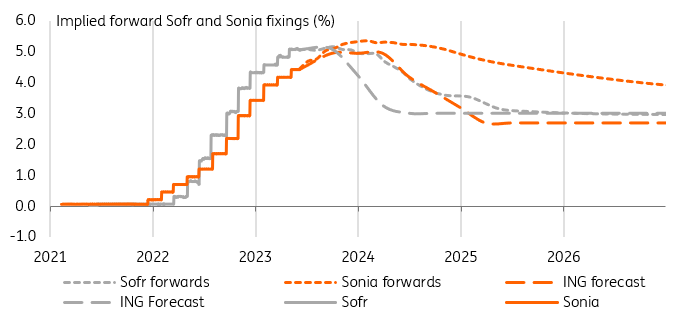The Fed will hold at this meeting, but expect some tightening from other sources ahead
Directionally, a decision to hold rates steady at this meeting should not have a material effect on the level of market rates. What’s more important is the tone and language used by Chair Powell, where a hawkish tilt should prevent yields from seeing this event as a rationale to move lower. A surprise hike would deepen the inversion and likely shift the curve materially higher (by some 10bp in the 10yr, and by 20bp in the 2yr). That said, a hike is highly unlikely given that the market attaches a 90% probability to a hold at this meeting.
We will also get the Fed’s updated forecasts and dot plot chart for individual forecasts for the path of the Fed funds rate. In March, the Fed signalled rates would be left in a 5-5.25% range through to year-end, with rate cuts in 2024. We suspect there will be only minor tweaks in their forecasts – our predictions for what they will say are in the table below. Nonetheless, the big risk is that even if the Fed do hold rates steady it inserts a further hike into their central forecast. This would likely see markets firmly swing in favour of a 25bp move in July.
Even as the Fed holds, there is set to be a material tightening in conditions in the weeks and months ahead. Bills and other bond issues that had been held back are now being accelerated as the US Treasury looks to rebuild its cash balance. To the extent that money market funds buy extra bills, this likely means less use of the Fed’s reverse repo facility. At the same time, as the Treasury’s cash balance is increased there should be an associated fall in bank reserves held at the Fed. This will make things feel that bit tighter.
A combination of extra floating collateral and less liquidity should place some upward pressure on repo rates, adding to the tightening being felt generally. Also, there is an underlying tightening coming from the rises in market rates seen in the past few weeks. This is largely a part reversal of the falls in market rates seen in the wake of the Silicon Valley Bank collapse. But still, this is helping the Fed to do the tightening job that it believes needs doing.
Pitted against that, however, has been a tendency for credit spreads to tighten, volatility to fall and Libor OIS to re-tighten. These act to loosen conditions, but are also a consequence of the reduction in system stress as the debt ceiling was suspended and banking fears have receded, both of which the Fed welcomes.
ING's expectations for what the Federal Reserve will forecast today

Sterling curve flattening accelerates on hot labour market
Unlike the Fed and the European Central Bank, the next Bank of England policy meeting is only next week. No matter, a hotter than expected labour market report put investors on high alert for continued hawkish monetary policy. This was not a huge surprise to markets that were already pricing more than 100bp of additional tightening in this cycle, rising to almost 130bp after the report. Assuming a 25bp hike per meeting, this should extend the hiking cycle to December of this year. This compares with the euro and dollar curves pricing around 50bp and 25bp more tightening this year from the ECB and Fed respectively.
Unlike previous instances of hawkish re-pricing, the rise in front-end rates has struggled to propagate to longer maturities. The resulting curve flattening means the UK curve is fast catching up to the inverted levels of its US equivalent. The limited level of inversion has long been a puzzle to us, given UK policy rates are already significantly in restrictive territory, and as the UK is facing similar growth headwinds to its developed market peers, thus justifying commensurate rate cut expectations.
One possible reason for the lack of flattening was fears that active quantitative tightening – outright gilt sales – were putting comparative steepening pressure on the curve. Another potential explanation could also have been expectations that, once at their peak, policy rates would need to be held there for longer. We have more sympathy for the former explanation, especially now that more inflationary data is finally resulting in curve flattening. The upshot is a more inverted curve in the UK for longer than in the US in particular, where we can point to (a) more progress against the Fed’s inflation target and (b) a clearer list of catalysts for inflation to revert to target.
Sterling rates now price higher rates for longer at the Bank of England than at the Fed

Today’s events and market view
The European releases calendar is thin with only eurozone industrial production expected to rebound in April from a dismal print in March.
Bond supply mostly consists in Germany adding a 10Y auction to an already busy week on the supply front (it launched a new 30Y green bond as well as auctioned 5Y debt yesterday).
The June FOMC meeting looms large on today’s markets. Consensus (6 out of 108 respondents favour no change in Bloomberg’s survey) and market expectations (a 25bp hike is priced with a less than 10% probability) are for no change in rate at this meeting after the May CPI report came in roughly in line with estimates yesterday. The lack of rate action will likely be offset by a more hawkish tone, including confirmation that a July hike is possible.
Ahead of the Fed, the US release calendar features PPI, which is expected to continue showing deflationary forces at play.
This article was first published on Think.ing.com.
